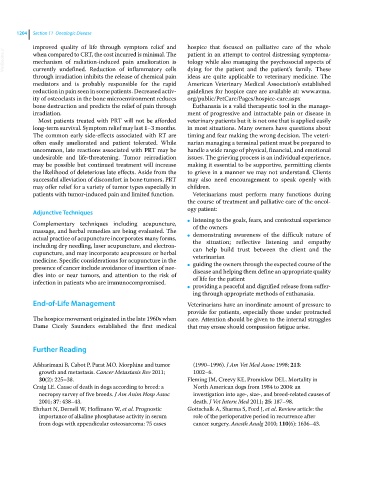Page 1266 - Clinical Small Animal Internal Medicine
P. 1266
1204 Section 11 Oncologic Disease
improved quality of life through symptom relief and hospice that focused on palliative care of the whole
VetBooks.ir when compared to CRT, the cost incurred is minimal. The patient in an attempt to control distressing symptoma-
tology while also managing the psychosocial aspects of
mechanism of radiation‐induced pain amelioration is
currently undefined. Reduction of inflammatory cells
ideas are quite applicable to veterinary medicine. The
through irradiation inhibits the release of chemical pain dying for the patient and the patient’s family. These
mediators and is probably responsible for the rapid American Veterinary Medical Association’s established
reduction in pain seen in some patients. Decreased activ- guidelines for hospice care are available at: www.avma.
ity of osteoclasts in the bone microenvironment reduces org/public/PetCare/Pages/hospice‐care.aspx
bone destruction and predicts the relief of pain through Euthanasia is a valid therapeutic tool in the manage-
irradiation. ment of progressive and intractable pain or disease in
Most patients treated with PRT will not be afforded veterinary patients but it is not one that is applied easily
long‐term survival. Symptom relief may last 1–3 months. in most situations. Many owners have questions about
The common early side‐effects associated with RT are timing and fear making the wrong decision. The veteri-
often easily ameliorated and patient tolerated. While narian managing a terminal patient must be prepared to
uncommon, late reactions associated with PRT may be handle a wide range of physical, financial, and emotional
undesirable and life‐threatening. Tumor reirradiation issues. The grieving process is an individual experience,
may be possible but continued treatment will increase making it essential to be supportive, permitting clients
the likelihood of deleterious late effects. Aside from the to grieve in a manner we may not understand. Clients
successful alleviation of discomfort in bone tumors, PRT may also need encouragement to speak openly with
may offer relief for a variety of tumor types especially in children.
patients with tumor‐induced pain and limited function. Veterinarians must perform many functions during
the course of treatment and palliative care of the oncol-
ogy patient:
Adjunctive Techniques
listening to the goals, fears, and contextual experience
Complementary techniques including acupuncture, ● of the owners
massage, and herbal remedies are being evaluated. The demonstrating awareness of the difficult nature of
actual practice of acupuncture incorporates many forms, ● the situation; reflective listening and empathy
including dry needling, laser acupuncture, and electroa- can help build trust between the client and the
cupuncture, and may incorporate acupressure or herbal veterinarian
medicine. Specific considerations for acupuncture in the guiding the owners through the expected course of the
presence of cancer include avoidance of insertion of nee- ● disease and helping them define an appropriate quality
dles into or near tumors, and attention to the risk of of life for the patient
infection in patients who are immunocompromised.
● providing a peaceful and dignified release from suffer-
ing through appropriate methods of euthanasia.
End‐of‐Life Management Veterinarians have an inordinate amount of pressure to
provide for patients, especially those under protracted
The hospice movement originated in the late 1960s when care. Attention should be given to the internal struggles
Dame Cicely Saunders established the first medical that may ensue should compassion fatigue arise.
Further Reading
Afsharimani B, Cabot P, Parat MO. Morphine and tumor (1990–1996). J Am Vet Med Assoc 1998; 213:
growth and metastasis. Cancer Metastasis Rev 2011; 1002–6.
30(2): 225–38. Fleming JM, Creevy KE, Promislow DEL. Mortality in
Craig LE. Cause of death in dogs according to breed: a North American dogs from 1984 to 2004: an
necropsy survey of five breeds. J Am Anim Hosp Assoc investigation into age‐, size‐, and breed‐related causes of
2001; 37: 438–43. death. J Vet Intern Med 2011; 25: 187–98.
Ehrhart N, Dernell W, Hoffmann W, et al. Prognostic Gottschalk A, Sharma S, Ford J, et al. Review article: the
importance of alkaline phosphatase activity in serum role of the perioperative period in recurrence after
from dogs with appendicular osteosarcoma: 75 cases cancer surgery. Anesth Analg 2010; 110(6): 1636–43.

